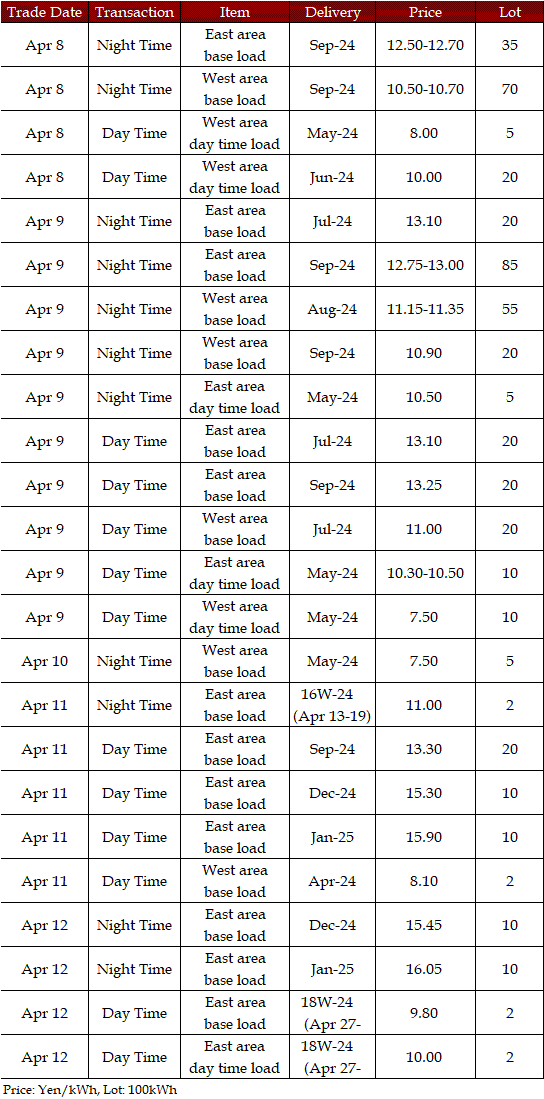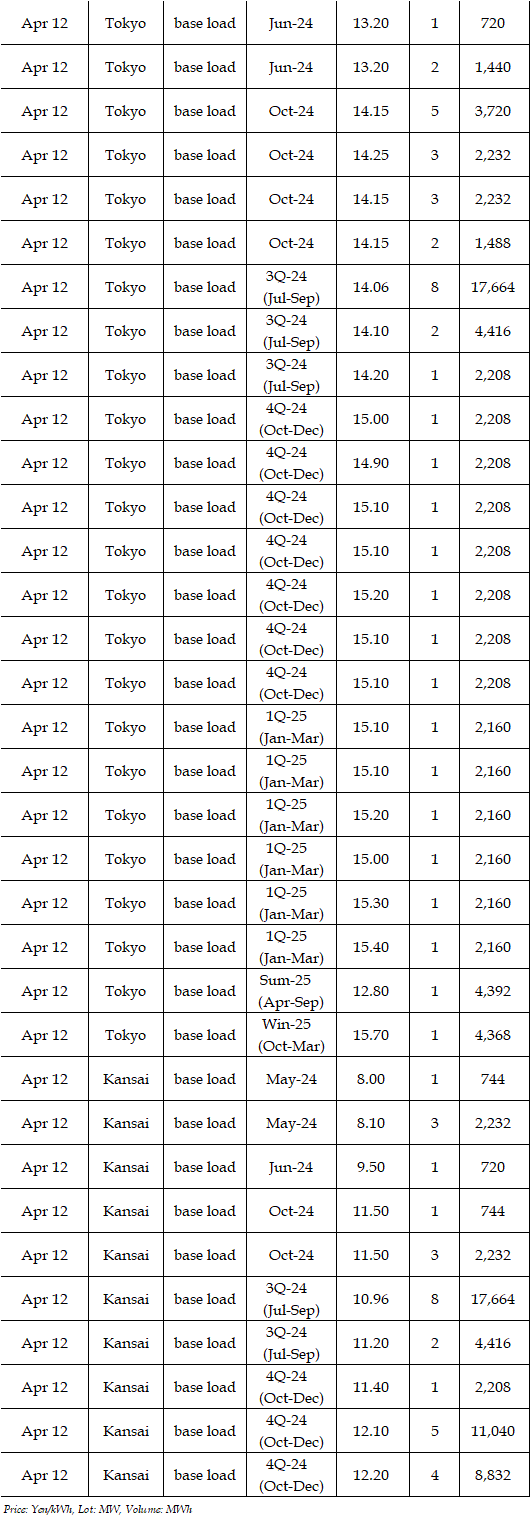|
In the day-ahead market on JEPX (Japan Electric Power Exchange), the 24-hour spot power prices on a weekly average basis for Apr 8-12 delivery rose in East Japan, but weakened in West Japan. The weather was rather cloudy than the previous week, but the temperatures stayed relatively mild, so that upside room in spot power prices was capped. Elsewhere, the non-peak demand season witnessed an increasing number of overhauls at interconnection lines as well as maintenance shutdowns of thermal units. During the week, the status of interconnection line maintenance gave a great impact on spot prices in East Japan and West Japan. Especially, heavy price decoupling was caused between Hokuriku and Kansai due to maintenance works conducted from Apr 8 to Apr 11 at the Minami-Fukumitsu Converter Station connecting Chubu and Hokuriku and the Mie-Higashi Omi Line connecting Chubu and Kansai. The Hokuriku-Kansai decoupling occurred in all of 48 windows for Apr 9 delivery and 47 windows for Apr 10 delivery, a factor that pushed wider the East-West differential in spot power prices.
In Tokyo and Kansai, the key areas in East Japan and West Japan, the 24-hour average posted a difference in favor of the East by Yen 1.97 for Apr 8 delivery, Yen 7.85 for Apr 9 delivery, Yen 5.90 for Apr 10 delivery, Yen 3.45 for Apr 11 delivery and Yen 5.08 for Apr 12 delivery.
In the fuel markets, LNG and coal prices edged up from the previous week. Crude oil prices eased moderately.
DES Northeast Asia spot LNG prices hovered in the mid $9 level per mmBtu for prompt May 2024 arrival as of the latter half of the week (Apr 11), up marginally by about 10cts from the end of the previous week (Apr 5). Northeast Asia entered the non-peak demand season, leaving gas demand slow. But the LNG market resisted downside pressure amid bullish factors in the overseas markets including escalating geopolitical risks in the Middle East and Ukraine and a slump in US gas supply. The Ministry of Economy, Trade and Industry (METI) announced on Apr 10 that Japan's LNG inventories for power generation grew by 120,000mt from the previous week to 1.60 mil mt as of Apr 7, posting a week-on-week rise for a first week in six. But the level was still far below 2.44 mil mt as of end-April last year and the average of past five years at 2.02 mil mt.
FOB Newcastle thermal coal prices in Australia hovered in the high $128 level per ton for April 2024 loading as of the latter half of the week. The level was down moderately by about 50cts from the end of the previous week. Coal demand slowed down, but a firmness in gas prices lent support to coal prices.
In the crude oil market, WTI crude for May 2024 stood in the high $85 level as of afternoon on Apr 12 while Brent crude for June 2024 was trading in the mid $90 level. Both WTI and Brent were down nearly 50cts from the end of the previous week. As mentioned above, geopolitical risks in the Middle East and Ukraine underpinned crude oil prices. But such bullish factors were offset by bearish factors including a hefty buildup in US crude oil inventories, leaving the crude oil market directionless.
The actual highest price during the week was at Yen 19.97 in five areas from Hokkaido to Hokuriku for Apr 9 and Apr 10 delivery. Meanwhile, the actual lowest price during the week was at Yen 0.01 in four areas from Kansai to Kyushu for Apr 9 delivery, all of nine areas and the System Price (SP) for Apr 10 delivery, Hokkaido and Tohoku for Apr 11 delivery, and six areas in West Japan for Apr 12 delivery.
By area, the weekly average of the 24-hour spot prices was at Yen 11.40 in Hokkaido, up Yen 2.26 from the previous week, Yen 10.96 in Tohoku, up Yen 2.33, Yen 12.25 in Tokyo, up Yen 1.26, Yen 11.17 in Chubu, up Yen 1.08, Yen 11.04 in Hokuriku, up Yen 1.24, Yen 7.40 in Kansai and Chugoku, down Yen 2.40, Yen 7.40 in Shikoku, down Yen 1.92, and Yen 7.30 in Kyushu, down Yen 2.50.
In the JEPX auction, volumes of offers were 1,039.96 mil kWh on a weekly average basis, down 2.6% from the previous week. Meanwhile, bids on a weekly average basis waned by 1.5% to 828.06 mil kWh. The weekly average of trade volumes decreased by 1.9% to 630.89 mil kWh.
Power demand in nine areas of Japan during Apr 8-12 was a combined 10,725.86 mil kWh, down 1.1% from 10,847.14 mil kWh during Apr 1-5. The figure was up 1.2% from the corresponding period a year earlier. Demand during Apr 10-14, 2023 after day of week adjustment was 10,597.05 mil kWh.
In the JEPX forward market, no deals were confirmed during Apr 8-12.
Deals reported on TOCOM (Tokyo Commodity Exchange) during Apr 8-12 were as below.

Deals reported on EEX (European Energy Exchange) during Apr 8-12 were as below.





In the third week of April, spot power prices are expected to stay in a similar range as the second week. The weather is forecast to be rainy in Kyushu and Shikoku on Apr 15, Chugoku as well Kinki to Tohoku on Apr 16, and Tohoku and Hokkaido on Apr 17. But other areas are forecast to have sunshine. Ample solar power supply will be available mostly during the week, and some areas may have a chance to see Yen 0.01. The temperatures are forecast to be above 20 degrees from Kyushu to Kanto mostly during the week. The levels will be too mild to use either air-conditioning or heating. Elsewhere, interconnection lines in both East Japan and West Japan are scheduled to undergo maintenance works. Spot power prices could show large volatility depending on the time zones.
|
JEPX: System Price (Day Ahead 24 hours)
|
|
Weekday Price
|
8-Apr
|
9-Apr
|
10-Apr
|
11-Apr
|
12-Apr
|
|
24-Hour Ave
|
11.19
|
11.51
|
8.58
|
11.08
|
9.79
|
|
Volume (MWh)
|
577,479
|
612,935
|
654,320
|
669,940
|
639,777
|
|
(unit: yen per kWh) (date: delivery day)
|
|
|

|